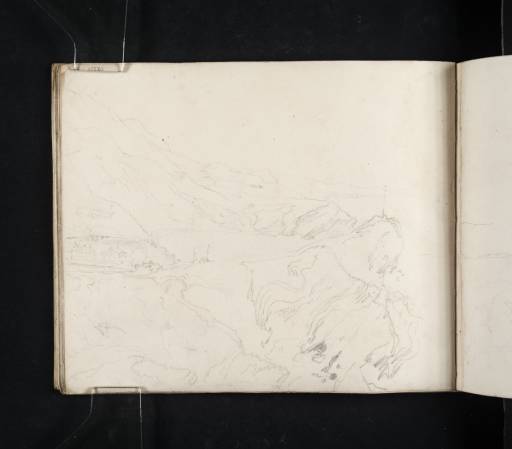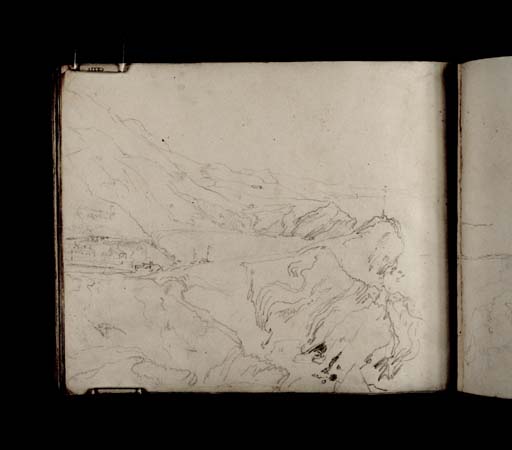Joseph Mallord William Turner Lulworth Cove and Stair Hole 1811
Image 1 of 2
Joseph Mallord William Turner,
Lulworth Cove and Stair Hole
1811
Joseph Mallord William Turner 1775–1851
Folio 22 Recto:
Lulworth Cove and Stair Hole 1811
D08833
Turner Bequest CXXIV 22
Turner Bequest CXXIV 22
Pencil on white wove paper, 170 x 209 mm
Inscribed by Turner in pencil ‘w’ towards top left, ‘[?Gravel]’ centre left, ‘R’ above cove at centre, and ‘w’ bottom centre
Blind-stamped with Turner Bequest monogram bottom centre
Stamped in black ‘CXXIV – 22’ top left, upside down
Inscribed by Turner in pencil ‘w’ towards top left, ‘[?Gravel]’ centre left, ‘R’ above cove at centre, and ‘w’ bottom centre
Blind-stamped with Turner Bequest monogram bottom centre
Stamped in black ‘CXXIV – 22’ top left, upside down
Accepted by the nation as part of the Turner Bequest 1856
Exhibition history
1998
Turner and the Scientists, Tate Gallery, London, March–June 1998 (105, reproduced).
References
1909
A.J. Finberg, A Complete Inventory of the Drawings of the Turner Bequest, London 1909, vol.I, p.354, CXXIV 22, as ‘Lulworth Cove’.
1979
Andrew Wilton, J.M.W. Turner: His Life and Work, Fribourg 1979, p.351 under no.449.
1981
Eric Shanes, Turner’s Rivers, Harbours and Coasts, London 1981, p.152.
1992
Howard J.M. Hanley, Turner in Dorset: Images from the Picturesque Views on the Southern Coast of England, exhibition catalogue, Mulberry Gallery, Weymouth Library 1992, p.24 no.24, reproduced.
1998
James Hamilton, Turner and the Scientists, exhibition catalogue, Tate Gallery, London 1998, pp.119, 141 no.105, fig.120, as ‘Geological Formations at Lulworth Cove’.
Turner’s view is from the highest point at the cliff edge west of Stair Hole, looking east beyond it to Lulworth Cove; the vantage point remains accessible by way of a steep climb. The mast on the promontory to the right is also evident in William Daniell’s 1823 aquatint of exactly the same view for his Voyage Round Great Britain, although it is there shown as a gantry with two uprights supporting a single mast on top (Tate impression: T02981). There was still a mast and adjacent coast-guard buildings there in the 1930s,3 but erosion has left only vestigial signs of buildings at that point today.
In discussing Turner’s interest in geology, James Hamilton has described this sketch as characteristic of ‘the maturity of a lifelong engagement with mountain, hill and rock forms that is underpinned by a certain knowledge of ... the dynamics of the folding of the earth.’4 The Lulworth Crumple, a serpentine kink in the strata at the far end of Stair Hole, is shown fairly accurately here, but exaggerated in the watercolour to form a shape like the outline of a giant head and shoulders.
There are other views of the cove on folios 20 recto, 20 verso, 21 recto and 21 verso (D08829–D08832). There are also two drawings in the Vale of Heathfield sketchbook (see under D08830 and D08832), perhaps made on the same occasion. Turner described the geology of the cove in verse in the Devonshire Coast, No.1 sketchbook (Tate D08479; Turner Bequest CXXIII 58).
Wilton 1979, p.351 no.449; long untraced, but for colour reproduction see Sir Charles Holroyd, W[illiam] G[eorge] Rawlinson and Alexander J. Finberg, The Watercolours of J.M.W. Turner, London 1909, pl.IX, reprinted in Shanes 1981, p.[59] and the same author’s Turner’s England 1810–38, London 1990, p.44).
Verso:
Blank, save for inscriptions by John Ruskin in red ink ‘27’ top right and ‘649’ bottom left.
Matthew Imms
February 2011
How to cite
Matthew Imms, ‘Lulworth Cove and Stair Hole 1811 by Joseph Mallord William Turner’, catalogue entry, February 2011, in David Blayney Brown (ed.), J.M.W. Turner: Sketchbooks, Drawings and Watercolours, Tate Research Publication, December 2012, https://www


